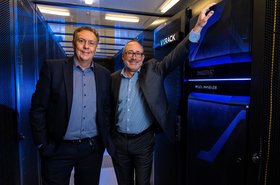As 2021 draws to a close and we wrap up our second year in the pandemic, the world continues to lean into digital transformation and the cloud. I shudder to think about what the economy, and business world in general, would look like without out all digital tools and the underlying data centers that make them run.
The vaccines brought light to the previously dark existence we experienced during the peak of the pandemic, allowing many of us to travel and attend some industry events in person again. After returning from my first in-person conference in September, I was greeted with a contact tracing app notice. Thankfully I tested negative, but as I write this in an airport lounge, time will tell if my recent travel proves foolish.
In my 2021 predictions, I called early 2021 a “still smoldering dumpster fire.” Little did I know that the smoldering fire would roar back to life fueled by the Omicron variant. As with my 2020 predictions, any shortcomings will quickly be blamed on Covid-19 and its unprecedented (anyone tired of hearing that word?) disruptions.
Did the construction industry hold up to the surging demand and finite resources? Did sustainability move from corporate social responsibility to competitive advantage? Read on and find out how accurately I predicted the socially distanced data center and tech trends of 2021.
1 Surging data center construction strains resources
Grade: A-
In making this prediction, I argued that the continued acceleration of digital transformation would ramp up the demand for data centers, placing extraordinary pressure on the global construction industry. Further, I argued that the leadership of experienced data center construction professionals would be at a premium and we would need to recruit from other technical industries to fill the skills gap.
For the most part, I did well in this prediction. The demand for data centers continues to rise and has put extreme pressure on the global construction industry. Experienced leadership is absolutely at a premium and many have succumbed to the temptation of promoting the bright, but less experienced builders before their time and accepting the associated risk. Prefabrication continues to take on a larger role in supplementing the finite on-site resources.
I have seen projects operate with ~200 less electricians than planned due to a skilled worker shortage. I will say that Europe has dealt with this better than the US by encouraging more to join the skilled trades instead of trying to route everyone to college. Could the construction industry follow the hyperscale cloud provider’s efforts to close the cloud skills gap by offering free training? Despite the strain, the construction industry continues to push forward with technology and brute force to meet the needs of the digital world.
Diversity is the solution to the impending silver tsunami
Grade: Incomplete
This was as much a statement as it was a prediction. This problem didn’t occur overnight, and it won’t go away that quickly either. At the time my predictions were written the average data center manager was a male in his 50’s. In the construction industry, critical to feeding the never-ending appetite for data centers, 88.6 percent of construction industry workers identify as white and over 90 percent are male. I have seen progress made here and there, but far more is needed to engage with more diverse sources of labor. This will continue to be one of the biggest threats to the success of the data center and tech industry for the foreseeable future.
Sustainability moves from corporate social responsibility to competitive advantage
Grade: C
Although sustainability has been at the forefront of the tech industry for years, it was my thinking that it would rise in importance and maturity in 2021. When measured through that lens – importance and maturity – I would say I was correct. All of the hyperscalers continue to ramp up their renewable energy purchases while a group of European data center operators and associations agreed to go climate neutral by 2030. More companies have committed to tracking their carbon, and with the rise of companies like Ledger8760, it’s getting easier to do so.
What I did not see is sustainability being a competitive advantage. I would argue that sustainability matured so quickly that it flew past being a competitive advantage to simply being table stakes. If you are a data center or cloud operator and wish to rise to the upper echelon of the industry, you need a serious commitment to sustainability in all of its forms (efficiency, renewable energy, recycling, etc.). In some cases, financing is being tied to sustainability metrics and clients will require a strong sustainability game for you to even be considered for their business. Never underestimate the value of sustainable branding.
Edge computing cements its symbiotic relationship with public cloud
Grade: A
This prediction was based upon my disagreement with a well-known market research firm predicting that new edge computing vendors would pull back 5 percent from public cloud computing growth. What we know for certain is that public cloud computing grew unabated in 2021. If new edge computing vendors did pull back anything from public cloud computing, it was a rounding error nowhere near 5 percent.
I would welcome any discussion on this if anyone can provide data to the contrary. It is still my contention that although edge computing has not taken off quite as quickly as many had predicted, vast amounts of new data will be created and eventually be moved to public cloud for storage. This isn’t a situation of either/or, but rather both creating the symbiotic relationship I predicted.
Edge computing leads to lights out data centers
Grade: D
Although I still firmly believe in the premise behind this prediction, I don’t have any data to give myself a better grade. I don’t think edge computing has taken off enough that the micro data centers that would operate in a lights out fashion have proliferated through the industry. So far, edge has flourished more in 2nd and 3rd tier markets rather than in more remote areas that will lead to more lights out data centers.
Perhaps this slow start for edge computing can be attributed in some way to the slow rollout of the game-changing millimeter wavelength 5G. It also may be due to the still-evolving use cases for edge that are still in debate. Whatever the case, this has led to the slower than predicted roll-out of lights out data centers, and sadly the dissolution of at least one edge computing company.
India’s colocation market takes center stage
Grade: A+
This has to be one of my most prescient predictions ever after having been proven correct shortly after being published. In February alone the Hiranandani Group announced a $1.1 billion investment in the 250 MW Yotta campus in West Bengal, EdgeConneX and Adani formed a joint venture to develop 1 GW of data centers in India, Reliance Jio announced a $950 million planned data center campus in Utter Pradesh, and Iron Mountain formed a joint venture with Web Werks to expand their footprint in India. These were followed by at least 15 other investment announcements throughout the year as chronicled by Datacenter Dynamics.
With a population of nearly 1.4 billion people, it was inevitable that India would take off as a data center and cloud market. It is a market where outsiders will struggle to do business without a local partner making colocation that much more attractive. Look for this market to continue its meteoric growth in the future.
How did I do?
My grades looked a little like the price of Bitcoin, pretty volatile. What do you expect from a construction guy making tech predictions? I am always interested in hearing how you think I did with my predictions. Please give me a shout in the comments section below, or on LinkedIn or Twitter. Also, keep an eye out for my 2022 predictions later this month, right here on Datacenter Dynamics.





